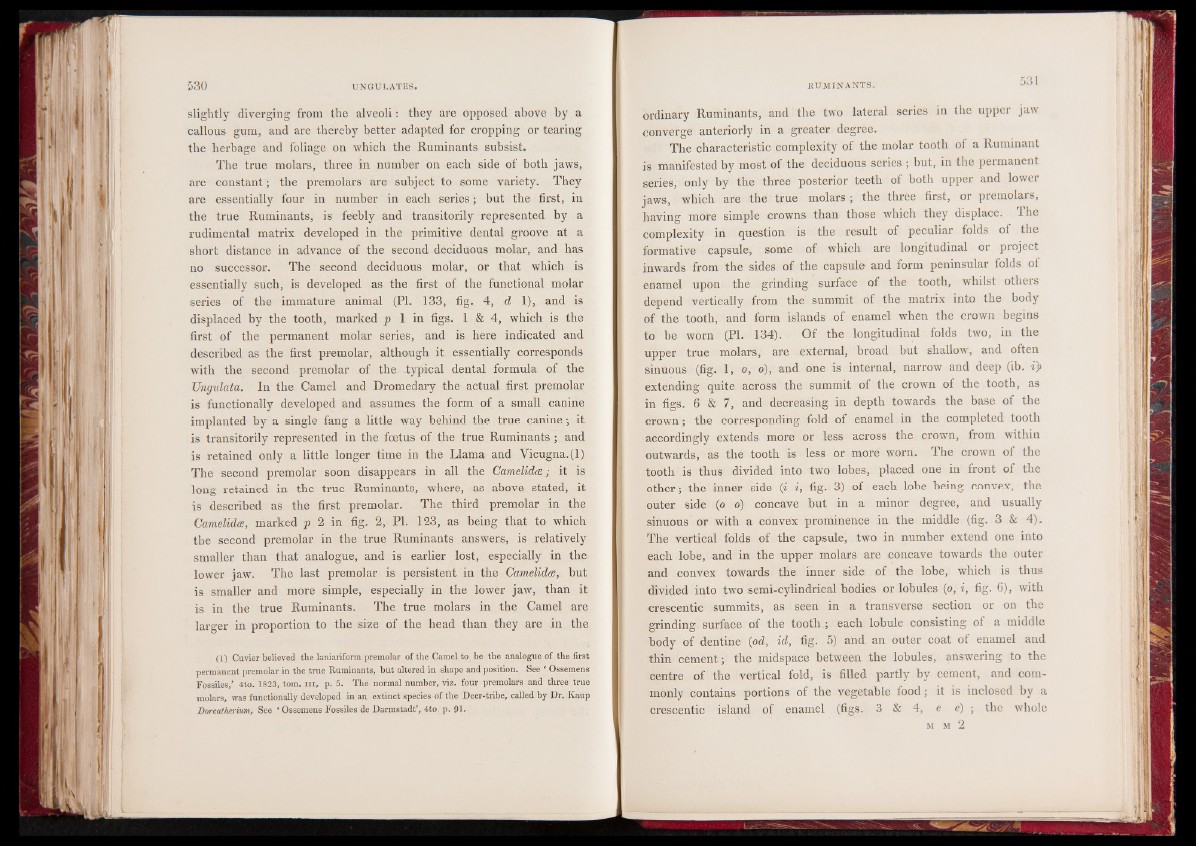
slightly diverging from the alveoli: they are opposed above by a
callous gum, and are thereby better adapted for cropping or tearing
the herbage and foliage on which the Ruminants subsist.
The true molars, three in number on each side of both jaws,
are constant; the premolars are subject to some variety. They
are essentially four in number in each series; but the first, in
the true Ruminants, is feebly and transitorily represented by a
rudimental matrix developed in the primitive dental groove at a
short distance in advance of the second deciduous molar, and has
no successor. The second deciduous molar, or that which is
essentially such, is developed as the first of the functional molar
series of the immature animal (PI. 133, fig. 4, d 1), and is
displaced by the tooth, marked p 1 in figs. 1 & 4, which is the
first of the permanent molar series, and is here indicated and
described as the first premolar, although it essentially corresponds
with the second premolar of the typical dental formula of the
Ungulata. In the Camel and Dromedary the actual first premolar
is functionally developed and assumes the form of a small canine
implanted by a single fang a little way behind the true canine; it
is transitorily represented in the foetus of the true Ruminants ; and
is retained only a little longer time in the Llama and Vicugna. (1)
The second premolar soon disappears in all the Camelida; it is
long retained in the true Ruminants, where, as above stated, it
is described as the first premolar. The third premolar in the
Camelidas, marked p 2 in fig. 2, PI. 123, as being that to which
the second premolar in the true Ruminants answers, is relatively
smaller than that analogue, and is earlier lost, especially in the
lower jaw. The last premolar is persistent in the CamelidcB, but
is smaller and more simple, especially in the lower jaw, than it
is in the true Ruminants. The true molars in the Camel are
larger in proportion to the size of the head than they are in the 1
(1) Cuvier believed the laniariform premolar of the Camel to be the analogue of the first
permanent premolar in the true Ruminants, but altered in shape and position. See * Ossemens
Fossiles,’ 4to. 1823, tom. Ill, p. 5. The normal number, viz. four premolars and three true
molars, was functionally developed in an extinct species of the Deer-tribe, called by Dr. Kaup
Dorcathei-ium, See ‘Ossemens Fossiles de Darmstadt’, 4to. p. 91.
ordinary Ruminants, and the two lateral series in the upper jaw
converge anteriorly in a greater degree.
The characteristic complexity of the molar tooth of a Ruminant
is manifested by most of the deciduous series ; but, in the permanent
series, only by the three posterior teeth of both upper and lower
jaws, which are the true molars; the three first, or premolars,
having more simple crowns than those which they displace. The
complexity in question is the result of peculiar folds of the
formative capsule, some of which are longitudinal or project
inwards from the sides of the capsule and form peninsular folds of
enamel upon the grinding surface of the tooth, whilst others
depend vertically from the summit of the matrix into the body
of the tooth, and form islands of enamel when the crown begins
to be worn (PI. 134). Of the longitudinal folds two, in the
upper true molars, are external, broad but shallow, and often
sinuous (fig. 1, o, o), and one is internal, narrow and deep (ib. i)s
extending quite across the summit of the crown of the tooth, as
in figs. 6 & 7, and decreasing in depth towards the base of the
crown; the corresponding fold of enamel in the completed tooth
accordingly extends more or less across the crown, from within
outwards, as the tooth is less or more worn. The crown of the
tooth is thus divided into two lobes, placed one in front of the
other; the inner side (i i, fig. 3) of each lobe being convex, the
outer side (o o) concave but in a minor degree, and usually
sinuous' or with a convex prominence in the middle (fig. 3 & 4).
The vertical folds of the capsule, two in number extend one into
each lobe, and in the upper molars are concave towards the outer
and convex towards the inner side of the lobe, which is thus
divided into two semi-cylindrical bodies or lobules (o, i, fig. 6), with
crescentic summits, as seen in a transverse section or on the
grinding surface of the tooth ; each lobule consisting of a middle
body of dentine (od, id, fig. 5) and an outer coat of enamel and
thin cement; the midspace between the lobules, answering to the
centre of the vertical fold, is filled partly by cement, and commonly
contains portions of the vegetable food; it is inclosed by a
crescentic island of enamel (figs. 3 & 4, e e) ; the whole
m m 2